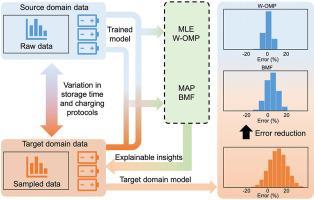Investigating explainable transfer learning for battery lifetime prediction under state transitions
IF 36.6
Q1 ELECTROCHEMISTRY
引用次数: 0
Abstract
Battery lifetime prediction at early cycles is crucial for researchers and manufacturers to examine product quality and promote technology development. Machine learning has been widely utilized to construct data-driven solutions for high-accuracy predictions. However, the internal mechanisms of batteries are sensitive to many factors, such as charging/discharging protocols, manufacturing/storage conditions, and usage patterns. These factors will induce state transitions, thereby decreasing the prediction accuracy of data-driven approaches. Transfer learning is a promising technique that overcomes this difficulty and achieves accurate predictions by jointly utilizing information from various sources. Hence, we develop two transfer learning methods, Bayesian Model Fusion and Weighted Orthogonal Matching Pursuit, to strategically combine prior knowledge with limited information from the target dataset to achieve superior prediction performance. From our results, our transfer learning methods reduce root-mean-squared error by 41% through adapting to the target domain. Furthermore, the transfer learning strategies identify the variations of impactful features across different sets of batteries and therefore disentangle the battery degradation mechanisms and the root cause of state transitions from the perspective of data mining. These findings suggest that the transfer learning strategies proposed in our work are capable of acquiring knowledge across multiple data sources for solving specialized issues.

研究状态转换下电池寿命预测的可解释迁移学习
早期电池寿命预测对于研究人员和制造商检验产品质量和促进技术发展至关重要。机器学习已被广泛用于构建数据驱动的解决方案,以实现高精度预测。然而,电池的内部机制对许多因素都很敏感,例如充电/放电协议、制造/存储条件和使用模式。这些因素会引起状态转换,从而降低数据驱动方法的预测准确性。迁移学习是一种很有前途的技术,它能克服这一困难,通过联合利用各种来源的信息实现准确预测。因此,我们开发了两种迁移学习方法--贝叶斯模型融合和加权正交匹配追寻,将先验知识与目标数据集的有限信息进行策略性结合,以实现卓越的预测性能。从结果来看,我们的迁移学习方法通过适应目标领域,将均方根误差降低了 41%。此外,迁移学习策略还能识别不同电池组的影响特征的变化,从而从数据挖掘的角度厘清电池退化机制和状态转换的根本原因。这些研究结果表明,我们在工作中提出的迁移学习策略能够从多个数据源中获取知识,从而解决专业问题。
本文章由计算机程序翻译,如有差异,请以英文原文为准。
求助全文
约1分钟内获得全文
求助全文

 求助内容:
求助内容: 应助结果提醒方式:
应助结果提醒方式:


